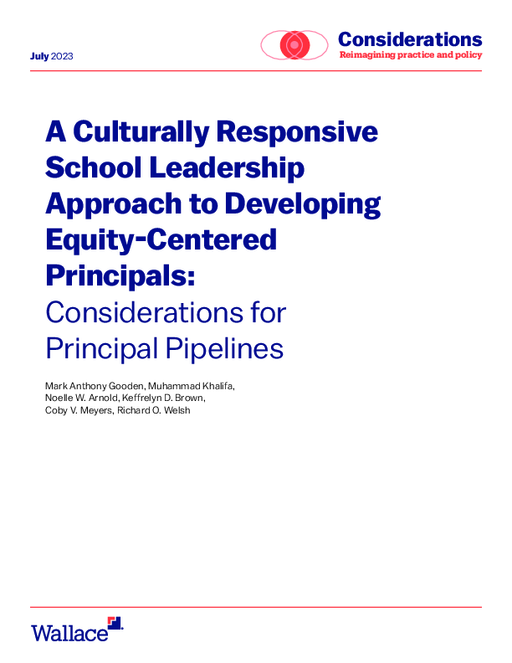Breadcrumb
- Wallace
- Reports
- A Culturally Responsive School L...
A Culturally Responsive School Leadership Approach to Developing Equity-Centered Principals
Considerations for Principal Pipelines
- Author(s)
- Mark Anthony Gooden, Muhammad Khalifa, Noelle W. Arnold, Keffrelyn D. Brown, Coby V. Meyers, and Richard O. Welsh
- Publisher(s)
- The Wallace Foundation
Summary
How we did this
The paper is based on a review of education literature and draws in large part from the influential Culturally Responsive School Leadership framework, developed by three education scholars, including two of the report authors.
Effective principal pipelines can lead to benefits for student outcomes. That's according to a groundbreaking 2019 study. But could these pipelines be designed to advance a district’s vision of equity as well? If so, what would that design look like?
That’s the question tackled in this think piece by six education scholars. The team considers how the pursuit of educational equity could be embedded in pipelines to the principalship.
The paper draws in large part from an influential framework developed several years ago by three scholars. (Among them were two members of the team.) The framework describes four key characteristics of equity-centered school leaders. The characteristics are:
- Having a “critical consciousness.” This is an understanding of historical oppression to inform how to achieve equity today.
- Ensuring schools are inclusive places where all feel welcomed
- Supporting teachers to provide culturally responsive classrooms
- Engaging with a range of community members to define what educational justice means for a school’s students

We hope this report adds to the excitement of making schools more equity-centered by recognizing that leaders and those who support them have a great deal of work to do.
The authors map these characteristics to the seven key parts of what are known as “comprehensive, aligned” principal pipelines. Such pipelines are comprehensive because they cover a range of actions districts can take to shape school leadership. They are aligned because their parts reinforce one another. The parts are known as “domains.” The domains include such things as adopting rigorous leader standards, supplying high-quality pre-service principal preparation, and supervising principals effectively.
Take the example of the domain of high-quality pre-service principal preparation. The authors suggest a number of possibilities. Among them:
- Critical consciousness. Principal preparation programs could promote this if they required program applicants to grapple with equity issues in interviews, role playing, and other admissions activities.
- Inclusive environments. Programs could promote this by teaching future school leaders such skills as how to conduct climate surveys and focus groups.
- Culturally responsive instructional leadership. Programs could equip leader candidates to recognize and support teachers' culturally responsive approaches.
Research about some domains is sparse. But for those, the authors are able to offer ideas. Take the example of data systems to inform leader hiring and other decisions. The authors say districts could use these systems to help identify a wider and more diverse array of candidates for leadership.
The authors end with overall considerations about embedding equity into pipelines. A key one is that those who write or revise standards for the principal’s job focus explicitly on equity and justice.
This report is part of an occasional Wallace series titled "Considerations." In the series, experts share insights based on research and theory on important issues in the areas where Wallace works.
Key Takeaways
- There are a range of strategies that districts can use to build equity-centered principal pipelines.
- Some parts of the principal pipeline, like leader development, are supported by more research-based evidence than others.
- Partnering with local community members, including but beyond students’ families, is critical for supporting responsive and equitable learning opportunities

